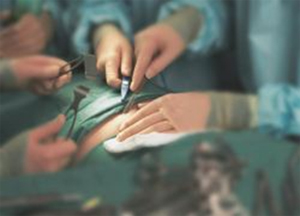Mengurangi Tingkat Surgical Site Infenctions Melalui Surgical Care Improvement Project
Oleh : Nasiatul Aisyah Salim SKM.,MPH
 Infeksi luka operasi merupakan urutan ketiga terbesar yang menyebabkan infeksi nosokomial. Lebih dari 15 juta prosedur pembedahan yang diselenggarakan di AS setiap tahunnya, sekitar 750.000 di antaranya muncul SSI sehingga menjadi kerugian langsung dan tak langsung bagi pasien maupun sistem pelayanan kesehatan. Selain itu infeksi luka operasi memperpanjang masa perawatan di rumah sakit (7-10 hari pasca operasi) sehingga meningkatkan biaya perawatan antara 10-20 %.
Infeksi luka operasi merupakan urutan ketiga terbesar yang menyebabkan infeksi nosokomial. Lebih dari 15 juta prosedur pembedahan yang diselenggarakan di AS setiap tahunnya, sekitar 750.000 di antaranya muncul SSI sehingga menjadi kerugian langsung dan tak langsung bagi pasien maupun sistem pelayanan kesehatan. Selain itu infeksi luka operasi memperpanjang masa perawatan di rumah sakit (7-10 hari pasca operasi) sehingga meningkatkan biaya perawatan antara 10-20 %.
|
Cause |
Faktor-faktor yang mempengaruhi terjadinya Infeksi Luka Operasi |
|
Patient characteristic
|
|
|
Operative characteristic (Intra operative issue) |
|
|
Operative characteristic (Intra operative issue) |
|
|
Operative characteristic (Post operative issue) |
|
World Aliance for patient safety (2005) menyatakan bahwa waktu terjadinya infeksi luka operasi sebagian besar ditemukan setelah hari ke tujuh pada saat pasien kontrol ke poliklinik atau kunjungan kerumah pasien dan hari ke tiga saat pasien rawat inap. Dan penelitian Johnson et al. (2006) menjelaskan tipe infeksi luka operasi yang biasa terjadi adalah infeksi luka operasi superficial (ciri-ciri nyeri dan sakit pada daerah pembedahan, luka kemerahan dan bengkak) dan Infeksi luka operasi deep incisional (ciri-ciri kemerahan, sakit pada daerah pembedahan, jahitan terbuka dan adanya pus).
Tabel. Pencegahan Infeksi Luka Operasi
|
NICE |
SHEA/IDSA |
|
Preoperative phase
Intraoperative phase
Postoperative phase
|
Surgical Care Improvement Project
Infrastructure
Computer-assisted decision support and automated reminders Antimicrobial prophylaxis Measure and provide feedback on process measures,e.g. hair removal Accountability
Non-routine approaches Vancomycin not routine for antimicrobial prophylaxis
Unresolved issues Preoperative bathing with chlorhexidine
Procedures Maintaining normothermia after colorectal surgery |
Sumber : (Humphreys, 2009)
Surgical Safety Checklist (SSC) milik WHO telah memperlihatkan penurunan tingkat SSI, komplikasi dan mortalitas. Haynes et al (2009) menunjukkan bahwa penerapan checklist dengan 19 item dalam periode perioperatif telah meningkatkan pengaturan waktu yang tepat untuk infusi antibiotik dari 56% menjadi 83% dengan pengurangan SSI secara signifikan dari 6,2% ke 3,4%.
Centers for Medicare and Medicaid Services mengembangkan Surgical Care Improvement Project (SCIP) dengan tujuan untuk mengurangi tingkat SSI hingga 10 %. Penilaian ukuran SCIP menggunakan pendekatan yang melibatkan multibidang seperti pengaturan waktu yang tepat untuk infusi antibiotik (SCIP Inf1), antibiotic selection (SCIP Inf2), penghentian secara tepat untuk antibiotik prophylactic (SCIP Inf3), appropriate hair removal method (SCIP Inf6), dan maintenance of perioperative normothermia (SCIP Inf10) dan euglycemia (SCIP Inf4).
Tabel. SCIP Inf performance measures verbally addressed in the Scott and White Surgical Safety Checklist
|
SSC Section |
SCIP Inf performance measures |
Verbal verification by surgical team |
|
Check in |
Inf-10 perioperative temperature management |
Estimated time for procedure |
|
Sign in |
Inf-10 perioperative temperature managemen |
Risk of hypothermia (operation > 1 h) |
|
Time Out |
Inf-2 antibiotic selection |
Appropriate antibiotic ordered |
|
Time Out |
Inf-1 antibiotic timing |
Antibiotic given within 60 min of incision (except vancomycin 120 min) |
Matthew et al (2013) menemukan bahwa SSC dengan ukuran kinerja mutu SCIP Inf meningkatkan persepsi komunikasi dan tindakan tim bedah dalam hal menghasilkan penurunan jumlah pasien hipotermia pada saat tiba di PACU (Post-anesthesia Care Unit). Penurunan SSI yang signifikan terlihat pada kelompok subspesialis bedah kolorektal dibanding bedah yang lain (cardiac, general, gynecologic, thoracic, vascular, orthopedic).
Kesimpulannya, penelitian Matthew et al (2013) menyatakan bahwa menggabungkan strategi SSI tertentu dengan standar SSC efektif untuk meningkatkan kinerja mutu. Selain itu seiring dengan perkembangan pelayanan kesehatan menuju program-program (pay-for-performance, for-value type programs), checklist yang menggabungkan ukuran kinerja dengan mutu proses perawatan akan menjadi alat yang efektif untuk meningkatkan reimbursement.
Referensi :
Merina, CH. (2011). Penggunaan Surgical Safety Checklist WHO pada Prosedur Penatalaksanaan Pembedahan di Kamar Operasi BLUD Meuraxa Kota Banda Aceh. Tesis. Universitas Gadjah Mada. Yogyakarta.
